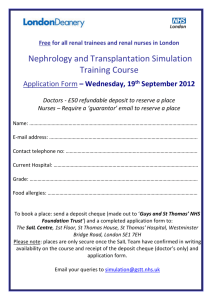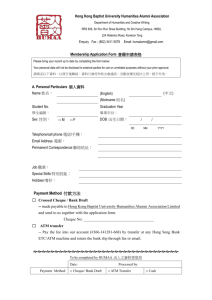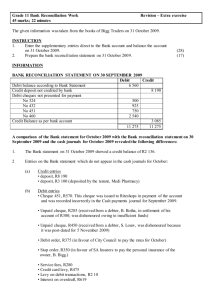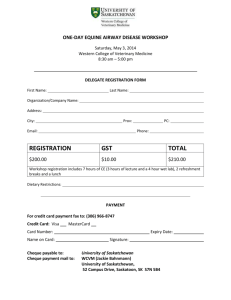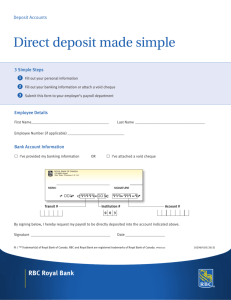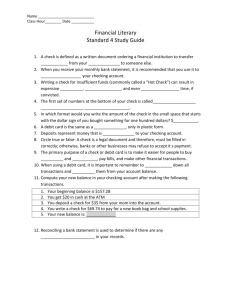Money and Banking - Junior Cert Business
advertisement
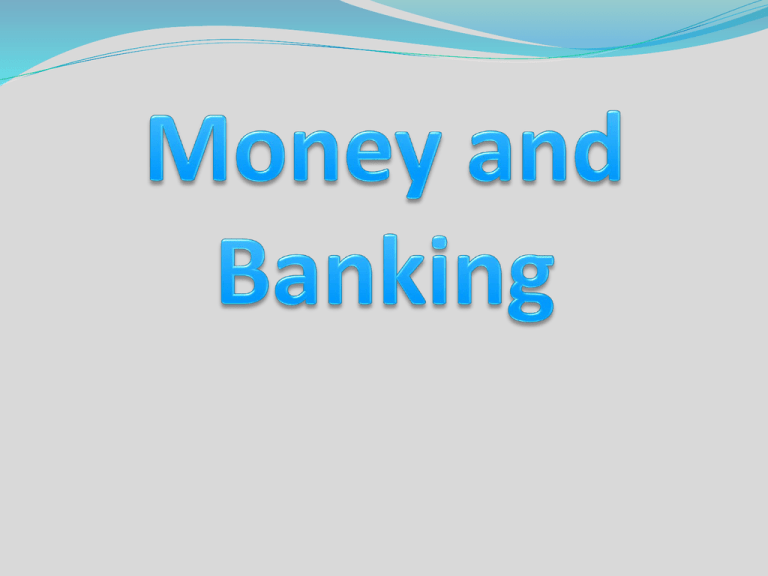
Before money was introduced, people had a system of barter or exchanging one product for another. The problems with barter led to the introduction of money, which had a standard value. Gold and silver were chosen and minted into coins. People gave their gold and silver to a goldsmith for safe-keeping. The goldsmith gave the person a receipt. These receipts were then used to buy goods and services. The person in possession of these receipts returned to the goldsmith and collected the gold. Forms of money today: Notes and coins – known as currency (Euro and cent) Cheques Plastic cards – Credit cards, Laser/Debit cards, Smart cards, ATM cards, Store cards, Charge cards. The Euro: The euro is the currency of Eighteen European Union countries namely Austria, Belgium, Cyprus, Estonia, Germany, Greece, Spain, France, Ireland, Italy, Malta, Luxembourg, the Netherlands, Portugal, Finland, Slovakia, Slovenia and Latvia. Euro notes and coins have been in cicurlation since January 2002. Benefits of the Euro: 1) Practical benefits for citizens – tourism has increased, as citizens can travel more easily with the Euro. No currency conversion is required for travel with the Euro zone. 2) Price comparisons – all goods and services are priced in Euros. 3) Reduced business costs – there are no bank charges on foreign currency transactions. Saving means not spending. Reasons for saving: To put money aside for emergencies. To earn interest on oney saved. To put a deposit on a house. To buy expensive items, e.g. A car. To pay for children’s education. To go on a holiday. Investing means making your savings work so that they will earn interest. Reasons for investing: To earn interest For safety reasons Factors to be considered before deciding where to invest The wise investor will consider the following; Safety - will savings be safe? Interest - will savings earn interest? Liquidity – will it be easy to withdraw savings? Tax – will the investor have to pay Deposit Interest Retention Tax (DIRT)? Future benefits – mortgage/loan. Convenience – suitable opening hours. Deposit Account: This is where you save money and earn interest on your deposits. Current Account: Holders of current accounts get an ATM card, A Laser/Debit Card and a cheque (by request). This is not a good account to use to save money as there is no interest paid and it’s too easy take out money. Financial institutions for investing your savings: 1) Commercial bank - Deposit Account Interest is paid and is subject to Deposit Interest Retention Tax (DIRT). Money is safe and can be withdrawn on demand. Examples: Ulster Bank, Bank of Ireland, Permanent TSB Bank 2) Building society – Deposit Account A competitive interest rate is paid on deposits. Interest is subject to DIRT. Savings record – you can apply for a mortgage (House Loan). Many branches around the country with convenient opening hours. 3) Credit union – Savings Account Interest on savings comes in the form of a dividend. Members can obtain loans at reasonable rates of interest. Local and convenient. 4) An Post – all savings invested with An Post are very safe. They are state-guaranteed. (a) Deposit account • Interest is paid on deposits. • Interest is subject to DIRT. • Withdrawls can be made at any branch of An Post. (b) Instalment saving • Save a fixed amount every month for twelve months. • The money is then left on deposit for a period of one to five years. • Guaranteed minimum rate of interest after five years. • Interest is tax-free. (c) Savings certificates • Guaranteed minimum return after five years and six months. • Interest is tax-free. (d) Savings bonds • Guaranteed minimum return after three years. • Interest is tax-free. 5) Stocks and shares • People could invest their savings in shares in companies. The investor would: Get a dividend. Make a capital gain if share prIce increases. Deposit Interest Retention Tax (DIRT) It is a tax earned by deposit account holders. It is deducted by the bank at source and transferred to the Revenue. The account holder is credited with the net interest. Cheque payments Cheque A person with a current account can make payments by cheque. Bank draft A bank draft is a cheque drawn by a bank on its own bank account. Very safe. Direct bank payments Standing order This is an instruction to a bank to pay a fixed amount from the account at fixed regular intervals to a specified firm or creditor, e.g. Rent, mortgage. Direct debit This is permission granted by an account-holder to a creditor to withdraw fixed or variable amounts from the account at any time, e.g. An ESB bill, Gas bill, Gym membership. Credit transfer This is a way of transferring money directly into another person’s or firm’s bank account. Pay path An electronic method for transferring wages from employers to the bank account of their employees. It is safer, convenient and timesaving method os paying wages. Card Payments 1) 2) Automated teller machine (ATM) – cash dispensers Customer is given an ATM card and a personal identification number, PIN. Customer goes to ATM at any bank, inserts card in machine, keys in PIN. Customer can lodge, withdraw, check their account balance, order a statement, order a cheque book, pay a bill. Credit card Buying goods now but paying at a later date. The credit card company pays the seller. The cardholder receives a monthly statement from the credit card company. If the cardholder clears his/her account each month, no interest or extra charges are payable. If the account is not fully cleared, a high rate of interest applies on the outstanding balance. 2) Credit card Government stamp duty applies. Examples are MasterCard and Visa. 3) Charge card Buying goods now but paying later. Account must be settled when statement arrives. Fee is paid to card provider for use. Examples : American Express and Diners Club. 4) Store card/fuel card Department stores and oil companies give their customers store/fuel cards. Customers are given a credit limit. Examples include: Esso, Texaco, Shell, Brown Thomas and Marks & Spencer. 5) Laser card/debit card Operates from a Current Account. The Laser Card is swiped in the seller’s terminal or card reader. The amount is entered (with cashback if required). The buyer enters their PIN number (signature can be used but no longer acceptable in stores unless customer is known). The amount of the purchase is instantly transferred from the buyer’s account to the seller’s account by electronic means. A receipt is printed for the customer. The cardholder may use it to withdraw cash. A) Legal requirements that must be satisfied when opening a bank account. Fill out an application form. Proof of the source of the money if it’s a large. Identification by means of a passport or driving licence. Proof of age. Proof of address by means of a utility bill. PPS number. B) Current account. If you want to use a cheque book to make payments you must open a Current Account. Money in a Current Account does not earn interest. C) How to open a current account Application form – name, address, occupation. Show proof of identity – passport/driving licence. Show proof of address – by means of a utility bill, e.g. ESB bill. Submit reference if not known to bank. Give specimen signature. Lodge money. You are given A/C number, cheque card, ATM card and PIN. D) Advantages of having a current account. Account holders: May withdraw money at any time using an ATM, cheque book or Laser. May get an overdraft or loan. Can arrange to have payments made by standing order or direct debit. Can avail of credit transfers. D) Advantages of having a current account. Account holders: Can pay bills by Laser card in shops. Petrol stations etc., all over the country. Can benefit from Paypath. Can have Internet and telephone banking. E) Lodging money to a current account Lodgement slip ATM lodgement Credit Transfer. F) Withdrawing money from a current account Withdrawl slip at bank counter Write a cheque ATM withdrawl Standing order or direct debit Laser card/Debit card Bank Overdraft A bank overdraft is where a person withdraws more money than the amount held in their account with prior permission of the bank. An agreed limit is set by the bank. Interest is charged on overdrawn amounts on a daily basis. An overdraft can be repaid at any time in variable amounts and should be cleared for 30 days each year. Conditions that must be met before a current account can be overdrawn. Established customer/banking history/savings record. Credit worthy/good credit rating. Is bale to repay/secure employment/regular income/wage/salary. Agrees to keep within the overdraft limit. The account must be cleared of the agreed overdraft limit within the time specified or within one year. Differences between a current account and a deposit account. Cheque books are given to current accoutn holders but not to deposit account holders. Current accounts usually don’t earn interest while depoist accounts do earn it. Overdrafts may be given on a current account and none with a deposit account. Regular payments can be made by standing order and direct debit from a current account only. A deposit account holder may receive a book for recording lodgements and withdrawls. Current account is used for day-to-day use while a deposit account is used for savings. Why banks refuse to cash a cheque If the cheque is stale If the drawer dies or becomes bankrupt. If the drawer has not enough money in the account. If the amount in words does not match the figures. If forgery is suspected. If the signature does not match the specimen signature. If the cheque is not signed. Cashing a cheque When you receive a cheque you can: (1) Lodge it to your bank account. (2) Endorse it and give it to someone else. (3) Cash it in a shop where you are known.
